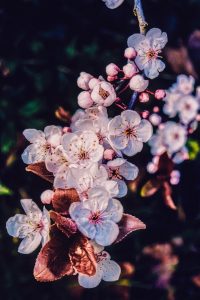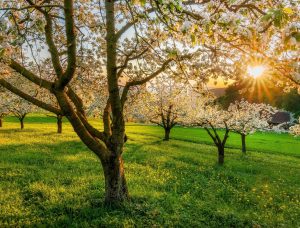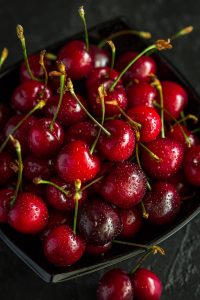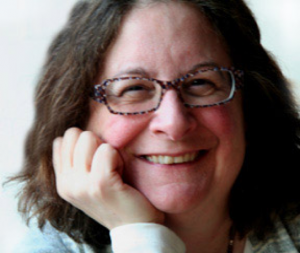Saturday
Featured Stories, Pacific NorthwestCherry Season
By Natalie Pascale Boisseau
Note: This piece contains sensitive content about suicide.
(French: [klafuti]; Occitan: clafotís [klafuˈtis] )
My love, when I look at the deep red cherries in the white bowl before me, the color of a sunburst heart, I become a citizen of the present moment. I forget that I am a foreigner in this country.
 Through the window, the sky is blue and the red maroon roof gently paled from sun exposure. I could be from anywhere, from my native Montreal to my adopted Seattle.
Through the window, the sky is blue and the red maroon roof gently paled from sun exposure. I could be from anywhere, from my native Montreal to my adopted Seattle.
My love, ever since we visited your uncle Kim and aunt Susan in the south of Los Angeles, three years ago, I have been craving clafoutis, with its baked cherries bursting with deep red sweetness activated by the sunlight. One night, when we visited, after buying a big bag of cherries, I said,“I will make dessert tomorrow. How about … clafoutis?” The word spilled from my mouth like raindrops of red sunshine.
Uncle Kim, always tied to the computer, searched for a recipe. In fact wherever one looks, on the internet or borrowed cookbooks, it is a similar recipe, simple and alive. The fruits are covered with a flan batter. It is made of eggs, milk, flour, and a little sugar.
It was something you and I have never made before. My French recipe books quietly lined up back in our home kitchen in Seattle are useless so far away south on the west coast. My mother who died from suicide when I was thirteen loved cooking for many people at all occasions. I still have all her cookbooks. Her passion for preparing a good meal and the company with loved ones, the aroma of her cooking has followed me to our home, in our marriage, in our lives in Seattle across the continent all the way from Montreal. Her cooking influences, however, have never laid clafoutis at our door. Clafoutis is free of nostalgia, free from traumatic edges, found in the food section of the newspaper. Why clafoutis? There is nothing to heal, to regret, to walk back home to, only the promise of a vibrant red new dessert to savor, placed on a white table cloth, waiting for me, for you, for our life together, for a new world. When your uncle Kim printed the recipe, and with your brown eyes, warm, knowing, curious of my improvisation, Clafoutis crossed centuries and cultures to finally reach me.
I am touched by the simplicity of the few ingredients, as simple as a refreshing meditation with the window open, a breeze from the Pacific Ocean—the roof red and the sky as liquid blue as the ocean seen from space. As simple as the moon bathing our presence, the felt warmth of our love.
Clafoutis is a word born from the Occitan language, once spoken in the south of France, parts of Spain, Monaco and Italy. During the Middle Ages, its troubadours were inspired to invent courtly love and the language spread through Europe. They traveled from villages to cities, with inventive songs, music and revelries, jesting with truth-telling in freedom and carrying clafoutis in their wake, baked in ovens of royalty and humble peasants alike, across boundaries in constant movement.
C’est le temps des cerises goes the old French song. It is the time of cherries, of love and summer, of their elusiveness and also of loss and broken hearts. I am not really French; I am Quebecoise, and the song holds layers of colonization from the French on native land and the subsequent abandonment of the colony to British occupation. The song celebrating the cherry time alludes to the French Revolution, the fratricidal blood of concitoyens, fellow citizens, that was spilled, and the bitter sweetness of the peace that followed, with the yearning for that peace to heal terrible wounds.
The loving melancholy of the song and of cherries never reached me until now. I was never in tune with June, the cherry season in Quebec, growing up after my mother’s suicide. It was early spring in Montreal and I was thirteen years old, a girl on the cusp of changes. June followed my mother’s death, and my mother’s death came the year after my dear uncle’s suicide. Grief has always visited me in early spring returning every year, stretching through my life like a never-ending winter.
Cerises is a word full of joy, but my loving mother had deserted me. Suicide is a war, and blood is spilled. How can one feel lightness and rejoice in the flaking beauty raining down, the first petals white turning rose with bloody infusion? Or enjoy eating the cherries harvested so far away from my native province, in Ontario or British Columbia? No, I had no awareness of the seasons of cherries and blossoming trees. I kept cherry joy at bay, my horizon limited to the small seasonal familiar strawberries of Quebec, with intense flavor, easily at reach as I walked in the field with my two brothers, their heavy soothing little heads lowered toward the ground. Our young bodies followed as we picked their sweetness one by one. Une par une was all I could do after my mother died.
For many years each April, I experienced the familiar tugs at my abdomen and sleepless nights captured me. My body braced itself again to the outcome that I could not prevent, the path my mother took when she carried her fury, her grief, her anguish and her distress like heavy rocks in her pockets in the weeks before she took her own life. As the first-born, the daughter, I am familiar with the pain now; I recognize swiftly, with alarm, the colliding pain, but as a girl I did not have the words to warn off the ominous disaster, and I have carried these rocks in my throat and my luggage across the country.
Suicide has banished my two brothers and me to a zone of present and future, away from our childhood, from the roots buried in our native land. We grew up as fruits hanging from the same stem, and we were suddenly split apart. The love I have for my family is accompanied by the shade of the disaster, a subtle dance avoiding the tragic effects on our lives. Suicide is the line one cannot encounter or cross without realizing there is no returning. It swallows the good early memories that have connected us because remembering them also awakens the shards of pain that followed. With the suicide, I buried the fresh essence of joy that ran through childhood, as if to save it for a later day.
I did not know that the cherry tree was already alive in me during the winters of my life, with its naked branches, dormant, under the snow.
My intuitive quest to taste my own essence, my healing, my freedom, brought me to Seattle, on the other shore, where I met you. You had also left your hometown in Pittsburgh to cross the continent to live in Seattle, following your passion for the ocean and its inhabitants – fish, salmon, sea anemones, coral reefs, oysters, octopus, whales, sea stars. I met you and kissed your lips red and shiny, and we became lovers, wives, friends, and companions. I gradually resurfaced from the sea of unresolved grief that never left me, took a breath, and observed the change of seasons with a new glee, like a rose promise, the long spring of Seattle starting in January, with purple plum trees and bright pink rhododendrons blooming.
It took longer to discover the opening of the cherry tree in my heart. It happened one day, in the month of March, during the lasting spring of Seattle, long before we visited Aunt Susan and Uncle Kim. You and I were settling in our newfound joy, in our small home, in the middle of the northwest forest. The day I felt the cherry tree in my heart was the day before the surgery that would finally remove completely the first cancer invading my body.
The year when my two cancers were found, I was learning to be a healer, an acupuncturist. My father had recently died, of natural causes, and the yearning to learn how to heal grasped me with urgency. All the unresolved pains in my life reemerged and led me to contemplate becoming a healer. I would become a different healer, not like my uncle, a doctor, who committed suicide the year before my mother, or my aunt, also a physician, who succeeded years later after three attempts. I would be a different kind of healer. When my father died, you and I had been living together for eight years. Under the heavy cloak of mourning, I was able to tell you of the death of my mother we could never speak of. I spilled rocks from my mouth. I was able to free myself from my father’s fear that I would be like my mother and kill myself. I was able to follow my intuitions and I allowed the tingly aliveness to surface over my body, no longer afraid that emotions might be the death of me. What is healing, I wondered? If a person, a family, a culture, a country is suffering, conflicted and tearing itself apart, how can it be healed?
I did not know then that the seeds of the cherry tree were already inside me, already growing.
The week before my cancer was diagnosed, I found myself sick with fever and abdominal pains. I asked the doctor, what is happening with my body? My body responded: there was a mass invading my abdomen slowly and quietly, a rare cancer made of lipid cells, ready to wrap itself around my vital organs. Later that year, after many tests and scans, cancer nodules were also discovered in my thyroid. Little toxic knots of grief seeded in my abdomen and my throat, planting themselves, knowing no boundaries as they grew in me. Instead of providing nourishment, my cells turned into invaders. The questions had still been following me. The large mass in my abdomen and the still-invisible little rocks in my throat whispered to me the unspoken words, “After so many years, how can you live after your mother committed suicide? Who are you to end the grieving of your mother’s unresolved death, who gave up on herself in defeat? Who are you to lift this blanket of shame woven with the threads of the unresolved conflicts of your mother which have torn her apart?” The day before my abdominal surgery, I stood under the canopy of a blooming cherry tree. Its petals enveloped me, the filtering light caressed my face, warming my skin. I felt I was resurfacing from the long winter of my life. Tomorrow will be a good day, I felt for the first time in months as I stood under the branches. My eyes half closed looked toward the soft sky of rose petals, teaching me that the loveliness of cherry sky has been there all along in me. In one moment, I was whole, and happy, suspended in the clear light of early spring.
In the following seasons, healing myself and others became my quiet exploration, while also convalescing and attending to my studies. I finally completed my training, set up my healing practices around Seattle, and offered weekly sessions of care to cancer patients in a hospital south of the city.
Together, you and I basked in the beautiful summer of recovery, going to the market every Sunday, where among all the summer fruits, cherries were offered in all tones of red.
 In the fall of my new life as a healer, you told me you felt this knot. You said to me, “I was warming my hands under my arms and I felt this lump.” In one week, we learned that cancer was now eating at your breast, and you already had this large knot in the lymph node under your arm. Many times during the long week of tests and exams, I had to close my eyes, dizzy, my head spinning. The overwhelming grieving returned, the bruising never ending. The fear of losing you clung at me, and its sharp edges brought me back in the present. The cherry tree in my heart pulled me where my love for you lives. I became the one caring for you, my cherished love and companion. Together we entered a new season of our lives. We stepped in the space where the moment is vivid, precious, where our lives can be taken at any time.
In the fall of my new life as a healer, you told me you felt this knot. You said to me, “I was warming my hands under my arms and I felt this lump.” In one week, we learned that cancer was now eating at your breast, and you already had this large knot in the lymph node under your arm. Many times during the long week of tests and exams, I had to close my eyes, dizzy, my head spinning. The overwhelming grieving returned, the bruising never ending. The fear of losing you clung at me, and its sharp edges brought me back in the present. The cherry tree in my heart pulled me where my love for you lives. I became the one caring for you, my cherished love and companion. Together we entered a new season of our lives. We stepped in the space where the moment is vivid, precious, where our lives can be taken at any time.
We shared our healing. The only way to not disappear in the fear of possibly losing you was to see you, to see myself, and to see my patients as whole beings, living in the season of being alive only in the present moment. The moment when the pink light shines through the spring cherry tree.
My first patients were no longer only sick people, they became allies. They whispered to me their secret remedies for their pains, digestive engorgements, sleepless nights, old age. How they took their medications with one ounce of tart cherry juice at night, how relieving the juice was to them.
After the long winters in my life, the spell was lifting. I resurfaced more often and noticed the world around me longer each time. The wind in the branches of the cherry tree sighs and wakes me up. Each time I resurface, grief recedes from its tidal wave. After long periods of internalized war, strife and hardening, the softness in me returns, expands in its aliveness. In the beginning, I felt the bruised parts. A little blemish over the skin of the cherry contains the world’s crushing pain, I learn, and also its returns to healing once cooked, when releasing reviving bright juices.
I discover the world is split between sour and sweet. Cherries become one or the other and never cross-pollinate, and their food stays whole inside you. They love temperate climates, spreading mostly from the Northern Hemisphere—from France, England, Italy, Northern India, and Morocco—from the Caspian Sea to the Balkans, to the Americas.
The native cherry trees offer their bark in honey-infused syrup against coughs. They grow side by side with the nonnative, cultivated with longing memories of cherry pie and lost countries. I have learned how they all love the chilling winter, long summer and benevolent sunshine, how they are easily afflicted by diseases, flies, fungi, aphids, cankers, and rots. When I return to my beloved and native Quebec after its long winter, I taste the small scarlet native cherries griottes exploding in my mouth – a sharp sour I mix with a little sweetness. The fruits prefer being handpicked, not shaken by mechanized implements and not sprayed by pesticide in order to spare their giving flesh.
In Seattle, cherries overflow the markets in June, July, even August, brought by farmers from the Okanagan Valley, eastern Washington, California. Their presence finds home in me every new season: the Rainier, the Lupins, the sweet black Bings. Their stone pits are a reminder to eat them mindfully, the heart meeting delight and hurt.
Journeying at your side, my cherished one, my love has expanded and the people from my past have returned to visit us, timid at first, their presence both soothed and soothing, as if my healing, our healing has healed them too. My mother, my aunt, my uncle, their siblings and their parents, and my cousins. My father too, and my whole family. My brothers appear to me whole, alive in their essence, the three of us no longer in exile. The gentle presence of the living and the spirits of those who passed away gathers around me, listening to the stories that want to be told. The joyful fire of cherries expands beyond you and me, to those who maybe are listening, beaconing to the beings of the past, the present and the future. The bowl of cherries on the white table cloth never empties in the season of the present moment.
The afternoon your uncle handed me the recipe, I washed the fruits. I chose the darker red ones and planted them whole with their pit inside for full saveur in the dough made of flour, eggs, milk and a little sugar. When I take a bite, my mouth is full of the old Occitan language from which the name “clafoutis” was given to the dish. “Clafir:” to fill me with your love, quietly sitting in the afternoon sun with Uncle Kim, Aunt Susan. And you.
Natalie Pascale Boisseau is writing a memoir on the suicide of her mother and the strangeness of healing, and a novel, poems and personal essays. She writes in French and in English. Natalie Pascale has published the story Time Capsule, to be published in the anthology Unmuted: Stories of Courage and Resilience by GenPride in October 2020, Le Terrain Vague, with Les Ecrits des Forges, poems and stories in the magazine Raven Chronicle, and articles on the creative process of the Cirque du Soleil. She was awarded the Best Specialized Articles in Quebec in 1990 on First Native Social and Legal Issues. Weaving in contemplative arts, she facilitates the workshop “The Writing Practice.” Natalie Pascale also works as an acupuncturist and healer north of Seattle.





